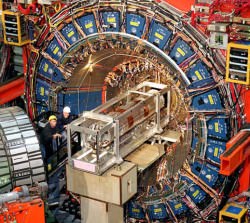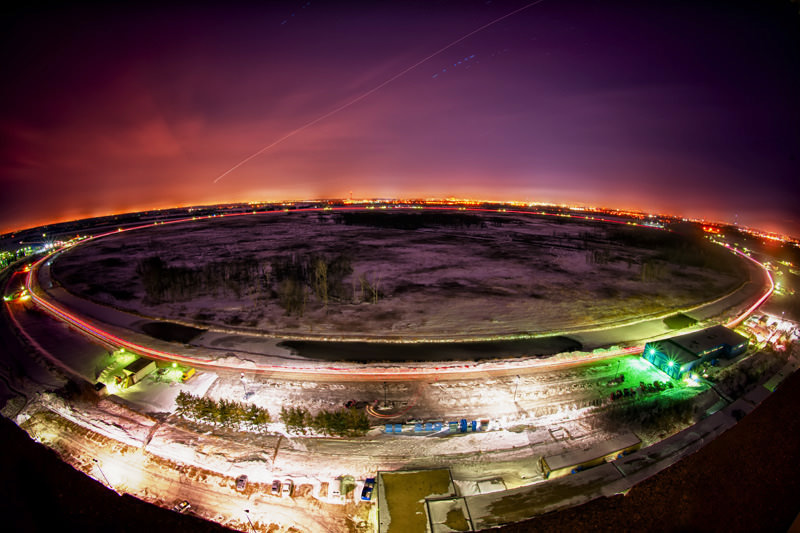Today, researchers from Fermilab announced they have zeroed in further on the mass of the Higgs boson, the controversially-called “God particle”* that is thought to be the key to all mass in the Universe. This news comes just two days before a highly-anticipated announcement by CERN during the ICHEP physics conference in Melbourne, Australia (which is expected by many to confirm actual proof of the Higgs.)
Even after analyzing the data from 500 trillion collisions produced over the past decade at Fermilab’s Tevatron particle collider the Higgs particle has not been identified directly. But a narrower range for its mass has been established with some certainty: according to the research the Higgs, if it exists, has a mass between 115 and 135 GeV/c2.
“Our data strongly point toward the existence of the Higgs boson, but it will take results from the experiments at the Large Hadron Collider in Europe to establish a discovery,” said Fermilab’s Rob Roser, cospokesperson for the CDF experiment at DOE’s Fermi National Accelerator Laboratory.
 Researchers hunt for the Higgs by looking for particles that it breaks down into. With the Large Hadron Collider at CERN, scientists look for energetic photons, while at Fermilab CDF and DZero collaborators have been searching for bottom quarks. Both are viable results expected from the decay of a Higgs particle, “just as a vending machine might return the same amount of change using different combinations of coins.”
Researchers hunt for the Higgs by looking for particles that it breaks down into. With the Large Hadron Collider at CERN, scientists look for energetic photons, while at Fermilab CDF and DZero collaborators have been searching for bottom quarks. Both are viable results expected from the decay of a Higgs particle, “just as a vending machine might return the same amount of change using different combinations of coins.”
Fermilab’s results have a statistical significance of 2.9 sigma, meaning that there’s a 1-in-550 chance that the data was the result of something else entirely. While a 5-sigma significance is required for an official “discovery”, these findings show that the Higgs is running out of places to hide.
“We have developed sophisticated simulation and analysis programs to identify Higgs-like patterns,” said Luciano Ristori, co-spokesperson of the CDF experiment. “Still, it is easier to look for a friend’s face in a sports stadium filled with 100,000 people than to search for a Higgs-like event among trillions of collisions.”
“We achieved a critical step in the search for the Higgs boson. Nobody expected the Tevatron to get this far when it was built in the 1980s.”
– Dmitri Denisov, DZero cospokesperson and physicist at Fermilab
Nearly 50 years since it was proposed, physicists may now be on the edge of exposing this elusive and essential ingredient of… well, everything.
See the Fermilab press release here.
Read Fermilab’s FAQs on the Higgs boson
Top image: The Tevatron typically produced about 10 million proton-antiproton collisions per second. Each collision produced hundreds of particles. The CDF and DZero experiments recorded about 200 collisions per second for further analysis. Sub-image: The three-story, 6,000-ton CDF detector recorded snapshots of the particles that emerge when protons and antiprotons collide.(Fermilab)
*And why is it often called the God particle? Because of this book.


Please never call it the god particle again. Not even ‘the controversially-called god particle.’ Especially not in a science-based column. It makes you look not so smart.
The poor Tevatron is feeling left out. The LHC is going to CONFIRM the existence of the Higgs Boson on Wednesday.
My respect for universetoday just went down the floor straight through the earth into a blackhole.
Seriously? The god particle? Is this the particle that belgium priest ages ago was talking about?
Can we please kill religion already? Thank you.
It is very clear from the video that it is, and has always been, the “Eddie Particle”.
“The Crazy Eddie Particle” Jerry Pournelle would like that. We may never get out of this Morass.
I also vote for not using the word “god particle” anymore since it has nothing to do with religion whatsoever.
I actually think “god particle” has nothing to do with religion. I think it has the meaning of master particle more then a religious meaning. It is as saying “I am my own god”: this line has also nothing to do with religion.
Thanks UT. That is the first time I’ve heard anything so understandable to me regarding the Higgs field and the God Particle. But since it gives mass, shouldn’t we call it the Pope particle, heh.
I would think that Universe Today would have enough sense not to call it the “god particle”. Nobody in the scientific establishment calls it that. In fact, that name is universally despised by particle physicists. Please stop using that name.
The Tevatron is making its “last hurrah” here, two days before the ICHEP meeting on the fourth. The data is at 2.9 sigma, which is not enough to make a definitive claim. However, these p-values might be combined (a complicated process) with the announced values the LHC detectors, which are anticipated to be over 5-sigma — the gold standard. Two data sets, even if one is sub-par, can be combined to boost p-values.
Leon Lederman deemed the Higgs particle the God particle. It might not have been the best choice of terms. However, Lederman made this statement because the Higgs field is what makes the matter world possible.
The W^{+/-} and Z get their mass by absorbing parts of the Higgs field, called the Goldstone boson parts H^{+/-} H^0. At low energy where the W and Z have mass this means there is a longitudinal component to the gauge field. If that persisted to very higher energy it would mean that the longitudinal field component oscillates with field components moving faster than the particle and ultimately the speed of light. So the longitudinal field was proposed to be a field effect, where that degree of freedom was taken from the Goldstone boson. The popular statement is that these parts of the Higgs field, called Goldstone bosons, are “eaten” by the W and Z. However, it really amounts to conservation of some degrees of freedom which permits the weak sector gauge bosons to be massless at very high energy with the Higgs field, but at lower energy three degrees of freedom in the Higgs field are taken up by the weak interaction bosons. There are interactions with other particles, which determines how quarks and leptons get mass. This involves Yukawa Lagrangians L = g bar-?_iH?_i..
It is important to remember there is a difference between the Higgs field and the Higgs particle. The Higgs particle in the standard model consists of two doublets (H^+,H^0) (H^-, h^0). The charged parts of the doublet are absorbed into W^+ and W^- and H^0 is absorbed into Z. There are also Yukawa couplings which determine how much of those fields are taken up by quarks and leptons. The remaining h^0 is the Higgs particle that is the focus of such study.
The Higgs field is a vacuum effect with a rather large vacuum expectation value ~ 174 GeV. This is troublesome for a number of reasons. Primarily this implies a huge cosmological constant that is some 12 orders of magnitude larger than measured. There is of course the related 120 orders of magnitude problem, where near Planck scale fluctuations wreck havoc. So now comes in supersymmetry, where the vacuum energy of bosons and fermions are opposite, so the fluctuations of a fermion or boson field are cancelled out by the supersymmetric partner. In the case of the Higgs field this implies the existence of the Higgsino field. This is a fermion with a gauge anomaly that is cancelled out by introducing another Higgsino field, and of course a Higgs field. Consequently there are four doublets, 8 components, and with the cancellation of three of these as in above there are then 5 left overs, massive and two charged Higgs particles. This then eliminates the huge Higgs vev.
LC
re “God Particle”
I’m wondering if the Higgs news out of CERN is favorable, as it looks to be, we might see headlines like “Scientists Find ‘Goddamn Particle'”. I’m sure it would give Leon Lederman a chuckle. :^)
When the LHC data on the Higgs was down in the dumps below 3-sigma there was a running commentary about not being able to find the goddamned particle.
LC
I say we call it the John Clinton particle.
Msrs. Morbius, mullins, Wijtman, et al.: Sites like UT are where the general public come to get educated a bit on things. Whether or not you approve, “god particle” is the name the popular media/culture have latched onto. Sites such as UT give the curious public a chance to understand why that is fundamentally not a correct term. Comments such as yours do not encourage that effort, but instead discourage it. One can only conclude that your immense scientific knowledge is all that separates you from the great unwashed, and for that I am truly sorry.
Nit-pick this to death please, all you name Nazis… GAWD! lol…
All very interesting. Thanks UT. The video is a good, simple intro too.
I really hope they will find this particle fast
Let’s just call it the “Higgs” and be done with it.
Get that Nobel Prize ready for Peter Higgs…